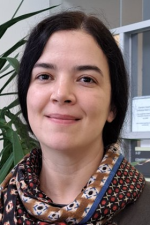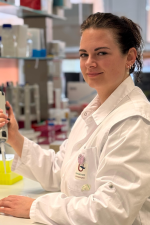Research focus
The Peripheral Neuropathy Research Group has a longstanding interest in understanding the complexity of peripheral nerve biology and the molecular pathologies causing inherited peripheral neuropathies (IPN). We discovered the first genetic cause for Charcot-Marie-Tooth disease (CMT1A duplication) and were subsequently involved in the discovery of 1/4th of the disease associated genes. Until now, more than 1500 monogenetic variants in over 90 genes have been shown to cause CMT and related IPN. Many of these genes code for proteins that are involved in myelination, axonal transport and maintenance of the PNS as one might expect. However, we also found mutations in housekeeping genes that lead to peripheral nerve degeneration.
 Prof. Vincent Timmerman
Prof. Vincent Timmerman
In recent years we made the transition from molecular genetics to functional analysis of a few of these disease causing genes, mainly focusing on small heat shock proteins.
We developed cell and animal models for disease (Drosophila and mouse models). We had tried to understand the delicate balance between peripheral nerve homeostasis and degeneration by studying:
- how specific genetic mutations lead to peripheral nerve degeneration, and
- the role of the innate immune system in this process.
The major challenge for the future is to identify a potential and appropriate drug target for a wide range of CMT subtypes. To address this, we are implementing two different approaches. First, we proceed with studying molecular pathways which are involved in several subtypes of CMT, including: a. RNA metabolism, b. autophagy and c. ER/mitochondrial crosstalk. Such biased approach has the advantage of contributing to basic knowledge on neuronal biology. Furthermore building on this expertise is relevant to maintain the pipeline for functional studies related to the identification of novel genes.
Our second approach is the use of unbiased omics approaches to identify drug targets applicable to a wide range of neuropathies. To this end, we develop new engineered cellular models using RNA interference, CRISPR/Cas mediated editing and induced pluripotent stem cell (iPSC) technology to mimic the disease biology more accurately. These newly developed disease models will be screened for differentially expressed proteins (mutant versus wild-type), which will be mapped to pathways allowing the identification of ‘common pathways’ affected in CMT neuropathies and related disorders. Thus, we are progressing from gene/mutation finding through understanding disease mechanisms and eventually contributing to the development of tools for therapeutic intervention.
Selected Publications
- Juneja,M., Burns,J., Saporta,M.A., Timmerman,V. Challenges in modelling the Charcot-Marie-Tooth neuropathies for therapy development. Journal of Neurology, Neurosurgery and Psychiatry 90(1): 58-67(2019): DOI
- Haidar,M., Asselbergh,B., Adriaenssens,E., De Winter,V., Timmermans,J-P., Auer-Grumbach,M., Juneja,M., Timmerman,V.: Neuropathy-causing mutations in HSPB1 impair autophagy by disturbing the formation of SQSTM1/p62 bodies. Autophagy 15(6): 1051-1068 (2019) DOI
- Juneja,M., Azmi,A., Baets,J., Roos,A., Jennings,M.J., Saveri,P., Pisciotta,C., Bernard-Marissal,N., Schneider,B.L., Verfaillie,C., Chrast,R., Seeman,P., Hahn,A., De Jonghe,P., Maudsley,S., Horvath,R., Pareyson,D., Timmerman,V.: PFN2 and GAMT as common molecular determinants of axonal Charcot-Marie-Tooth disease. Journal of Neurology, Neurosurgery and Psychiatry 89(8): 870-878 (2018) DOI
- Krols,M., Detry,S., Asselbergh,B., Almeida-Souza,L., Kremer,A., Lippens,S., De Rycke,R., De Winter,V., Müller,F-J., Kurth,I., McMahon,H.T., Savvides,S.N., Timmerman,V.*, Janssens,S*.: Sensory-neuropathy-causing mutations in ATL3 cause aberrant ER membrane tethering. Cell Reports 23(7): 2026-2038 (2018) (PMID: 29768202) DOI
- Bouhy,D., Juneja,M., Katona,I., Holmgren,A., Asselbergh,B., De Winter,V., Hochepied,T., Goossens,S., Haigh,J.J., Libert,C., Ceuterick-de Groote,C., Irobi,J., Weis,J., Timmerman,V.: A knock-in/knock-out mouse model of HSPB8-associated distal hereditary motor neuropathy and myopathy reveals toxic gain-of-function of mutant Hspb8. Acta Neuropathologica 135:131-148 (2018) DOI
Team

Vincent Timmerman
Group Leader
Jonathan Baets
Staff Scientist
Bieke Bekaert
Post-Doctoral Researcher
Biljana Ermanoska
Post-Doctoral Researcher
Stijn in't Groen
Post-Doctoral Researcher
Tim Vangansewinkel
Post-Doctoral Researcher
Geert de Vries
PhD student
Freke Mertens
PhD student
Sergei Grintsevich
PhD student
Ayesha Kiran Mendes
PhD student
Melanie Van Brussel
PhD student
Andrea Abou Yaghi
PhD student
Sam Dams
PhD student
Vicky De Winter
Lab Technician
Tamira van Wermeskerken
Technician
Alice Monticelli
Technician
Nathan Donies
Associate Scientist
Nell Delgouffe
Master student
Jarne Bruyns
Master student